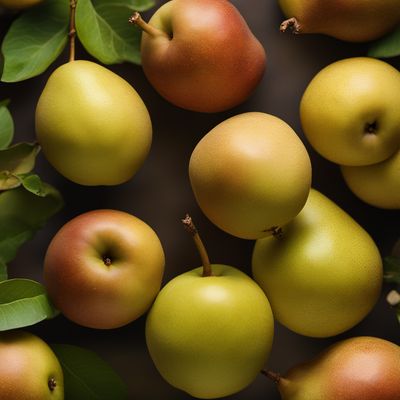
Ingredient
Wild pears
Nature's Sweet Gems: Exploring Wild Pears
Wild pears have a distinct flavor that is often described as sweet, slightly tangy, and floral. They have a firm yet juicy texture, with a grainy flesh that adds a pleasant crunch. The skin of wild pears can vary in color, ranging from green to yellow or even reddish hues, depending on the variety.
Origins and history
Wild pears have been enjoyed for centuries and are believed to be one of the oldest cultivated fruits. They are native to various regions around the world, including Europe, Asia, and North America. In many cultures, wild pears hold symbolic and cultural significance, often associated with fertility, abundance, and prosperity.
Nutritional information
Wild pears are a good source of dietary fiber, vitamin C, and antioxidants. They are also low in calories and fat, making them a healthy choice for snacking or incorporating into recipes.
Allergens
There are no known allergens specifically associated with wild pears. However, individuals with known allergies to other fruits in the Rosaceae family, such as apples or peaches, may be more susceptible to allergic reactions.
How to select
When selecting wild pears, look for fruits that are firm, with no signs of bruising or damage. The skin should be smooth and free from blemishes. Avoid pears that are overly soft or have a strong odor, as these may indicate overripeness or spoilage. Additionally, consider the ripeness level desired for your intended use, as wild pears can be enjoyed both when slightly underripe or fully ripe.
Storage recommendations
Wild pears should be stored at room temperature until they reach the desired level of ripeness. Once ripe, they can be refrigerated to prolong their freshness. It is best to consume wild pears within a few days of ripening to enjoy their optimal flavor and texture.
How to produce
Wild pears can be found growing in the wild or foraged from trees in certain regions. However, they are not commonly cultivated on a large scale. If you have access to wild pear trees, you can harvest the fruits when they are ripe and ready to be picked. It is important to obtain permission if foraging on private property and to follow sustainable harvesting practices to preserve the natural ecosystem.
Preparation tips
Wild pears can be enjoyed fresh as a snack, added to salads for a burst of sweetness, or used in both sweet and savory recipes. They can be poached, baked, or grilled to enhance their natural flavors. Consider incorporating wild pears into desserts, jams, chutneys, or even savory dishes like salads or roasted meats for a unique twist.
Culinary uses
Wild pears are commonly used in traditional recipes from various cultures around the world. They are often featured in desserts such as pies, tarts, and crumbles. Additionally, they can be used in savory dishes like salads, sauces, or as a complement to roasted meats. Wild pears are more commonly available in regions where they grow naturally or are cultivated on a smaller scale.
Availability
Europe, Asia, North America

